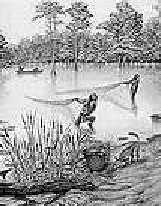
Netting for fish in a floodplain lake.
|
Even a casual review of artifacts recovered from archaeological sites should
make it clear that not all types of tools used by Mississippian peoples have
been recovered. To a large degree, this is a matter of preservation. Tools
made from plant materials quickly decompose and disappear from the
archaeological record. Artifacts
that would only be preserved in special circumstances (such as dry rock
shelters and caves, or carbonized pieces) include wooden arrow shafts, bow
strings, bow stays, gourd bowls, gourd spoons and dippers, mats, woven bags,
nets, fish weirs, baskets, and all fashion of clothing. In spite of not being
preserved, these and other organic implements were important to Mississippian
life.
For example, if ethnohistorical accounts and the frequency of fish bones from
some Mississippian sites are any indication, fishing nets and possibly weirs
must have played a key technological role in Mississippian subsistence economy
(ECON). Nets were probably constructed of twisted plant fibers. Weirs were
likely made of both small woven nets, wooden poles, and pliable, green twigs
cages. No weirs have been recovered from the American Bottom, but remnants have
been found north of Aztalan along the Crawfish River in Wisconsin and
throughout the southeast.
|
